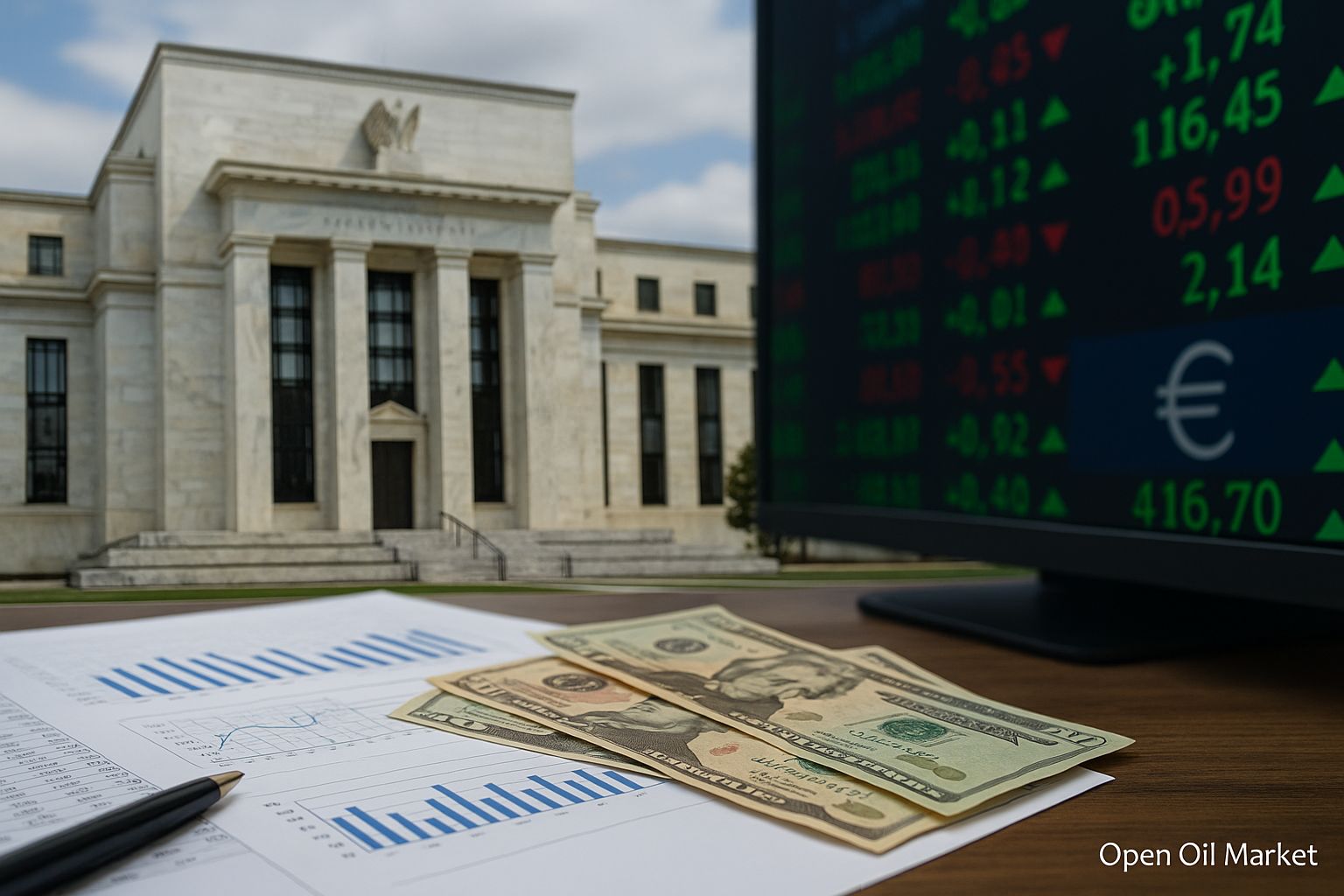
Detailed Review of Economic Events on Monday, August 25, 2025: Signals from the Fed on Rate Cuts, Ifo Business Climate Index in Germany, U.S. Housing Market Data, and Corporate Earnings Reports from Major Companies
The new trading week begins with cautious optimism in global markets. Investors are digesting the signal from the U.S. Federal Reserve regarding a possible interest rate cut as early as September, announced during the symposium in Jackson Hole. Against this backdrop, bond yields have decreased, the dollar has weakened, and demand for riskier assets has risen. In Europe, the focus is on the Ifo business climate index for Germany, which will reflect business sentiments amidst the region's economic stagnation. In the U.S., data on business activity from the Chicago and Dallas Federal Reserve banks will be released, along with fresh housing market statistics. British markets will be closed due to a bank holiday. Additionally, major publicly traded companies will report their earnings—from a Chinese internet giant to an American aircraft components manufacturer. Below is a closer look at the key events and market expectations for August 25, 2025.
Economic Calendar (Moscow, MSK)
- United Kingdom: Bank Holiday (markets are closed).
- 11:00 – Germany: Ifo business climate index for August.
- 15:30 – U.S.: Chicago Fed national activity index for July.
- 17:00 – U.S.: New Home Sales for July.
- 17:30 – U.S.: Dallas Fed manufacturing index for August.
Fed Signals Easing Policy
The rhetoric of the U.S. central bank has become the main driver for the markets. In a Friday speech, Fed Chair Jerome Powell cautiously hinted at the possibility of a rate cut as early as September, citing signs of a weakening labor market and moderate inflation. Although Powell did not make any direct promises, investors interpreted this as confirmation of a shift towards an easing monetary policy. Consequently, the yield on 2-year U.S. Treasuries fell by approximately 10 basis points (to about 3.7%), while the yield on 10-year Treasuries decreased to 4.25%. The drop in yields was immediately reflected in the markets: the S&P 500 soared by 1.5%, approaching historical highs, the Dow Jones reached a new closing record, and the Nasdaq strengthened due to gains in the technology sector. Lower rates increase the appeal of risk, with interest-sensitive segments showing significant increases—from small companies (Russell 2000 index: +3.8% for the day) to homebuilding companies (PHLX Housing index rose by 4.6%).
The U.S. dollar weakened significantly following the Fed's signals. The DXY dollar index dropped by nearly 1%, as lower rates make the American currency less attractive. The euro strengthened to 1.16–1.17 $/€, reaching levels not seen since last year, while the British pound rose to about 1.34 $/£. The improved risk appetite also supported currencies in emerging markets. However, some analysts caution that the euphoria may be premature if any signs of stagflation—a combination of weak growth and persistent inflation—emerge. Powell emphasized that further actions by the Fed would depend on incoming data, and important statistics regarding the labor market and prices (PCE, CPI) are due before the next meeting. Nevertheless, at present, market participants are pricing in an approximately 80% likelihood of a Fed rate cut in September, setting a positive tone for the start of the week.
Europe: Business Sentiment and Trading Cessation in London
In Europe, the main macro indicator of the day is the Ifo business climate index in Germany. The index for August is expected to remain close to the level of the previous month (in July, the index increased from 88.4 to 88.6 points—a one-year high—but still below average values). German businesses are currently assessing the situation cautiously: high costs, expensive loans, and weak external demand are keeping business confidence at a low level. Should the Ifo reveal an unexpected deterioration in sentiment, it would heighten concerns about recession in the largest economy in Europe. Conversely, a rise in the index would signal positive news for European markets, supporting the DAX index and the broader Euro Stoxx 50.
Trading in London will not occur on August 25 due to the bank holiday (Summer Bank Holiday). The absence of British investors could lower overall volumes and liquidity on European markets this Monday. Market participants in continental Europe will focus on the data from Germany and the dynamics of the euro exchange rate. The euro's strength in the wake of dovish signals from the Fed reflects improved global sentiment but could also weigh on shares of exporters in the Eurozone. Overall, discussions continue regarding further steps from the European Central Bank: weak business surveys and the lack of a trading session in the UK create a relatively calm backdrop, but investors are closely assessing any signals that could impact the ECB's policy (such as inflation trends and regulatory comments). As autumn approaches, many expect the ECB to pause the rate hike cycle, considering the cooling economy in the Eurozone.
U.S.: Business Activity and Housing Market Indicators
The American economic data block on Monday includes several indicators reflecting the state of the U.S. economy. The first is the Chicago Fed National Activity Index (CFNAI) for July. This composite indicator is calculated based on 85 economic indicators. In June, its value was slightly negative (-0.10), indicating that economic growth was below the average trend. The forecast for July is around -0.05…0.0, which would imply growth close to zero. Stabilization of the CFNAI suggests that the U.S. economy maintains moderate growth: improvements in certain sectors (e.g., industrial production and consumption) offset weakness in others. Investors are particularly noting components related to production and employment—whether they confirm the Fed's statements about a slowdown in the economy is crucial.
Following the composite index, a more specialized regional survey will be released—the Dallas Fed manufacturing index for August (at 17:30 MSK). The July release of this index was surprising: the indicator bounced from negative territory (-12.7 in June) to a slight positive (+0.9) in July, signaling a trend reversal for the Texas manufacturing sector. If the August figure holds around zero or improves, it will confirm that the manufacturing sector in the oil and gas heart of the U.S. is beginning to emerge from a downturn. Factors influencing the region include stable high oil prices supporting oil services and related industries, while the re-launching of supply chains improves conditions for factories. Nevertheless, a sharp industrial rebound is not anticipated at this time—softer Fed policy and rate cuts may only gradually improve conditions for producers.
Finally, an important release for the housing market—New Home Sales in the U.S. for July (data will be released at 17:00 MSK). Analysts are forecasting a slight decline: an annual sales pace of approximately 620,000 homes is expected, compared to 627,000 in June (-1.1% month-over-month). In June, the new home market unexpectedly grew by 0.6%, despite expensive mortgage loans. However, the increase in mortgage rates to multi-year highs continues to restrain buyers—housing is becoming less affordable. At the same time, inventory in the secondary market is limited (many Americans are not selling homes tied to old low-interest rates), so some demand is shifting towards new constructions. Developers note that high costs for building materials and labor are also hampering activity. July data will reveal whether the market can withstand the new rate environment: moderate decreases in sales fit within the picture of a "cool, but not frozen" housing sector. For investors, housing numbers are significant as indicators of consumer demand and household financial health. An increase in sales would support shares of construction companies, but even a slight decline within forecast limits would not be shocking—the market has already priced in the factor of high borrowing costs.
Corporate Earnings: Pinduoduo, HEICO, and More
On August 25, market attention will also be on the earnings reports of several large publicly traded companies for the past quarter. Among the most significant:
- PDD Holdings (PDD) – Chinese e-commerce platform (owner of Pinduoduo). The company will present its Q2 results before the opening of the U.S. market. Analysts expect net income to decline compared to last year, despite revenue growth, due to costs associated with business expansion and moderate consumer demand in China. Investors will watch active user growth and sales volume on the platform, as well as management's comments regarding competition with Alibaba and expansion into overseas markets.
- HEICO Corporation (HEI) – American manufacturer of aerospace and electronic components. The company will report after the close of trading in the U.S. The earnings per share forecast for the third financial quarter is around $1.13 (+17% year-over-year). The focus will be on the continuation of revenue growth due to high demand in the aviation sector (airlines are actively restoring fleets, increasing parts purchases) and stable orders from the defense sector. Key metrics will include margins and order backlogs, indicating the company's prospects. HEI shares have outperformed the market in recent months, so any deviations from those forecasts may lead to significant stock price movements.
- Semtech (SMTC) – California semiconductor company specializing in chips for communications and IoT devices. Financial results will be published after trading. The manufacturer has had a challenging year due to a downturn in industrial electronics, but the market expects a gradual recovery in demand. A quarterly profit of approximately $0.40 per share is anticipated. Investors will assess comments on stock inventory levels and the recovery of orders from clients in the telecom and IoT sectors. Management's forecast for the second half of 2025 is also crucial: improved revenue or profit guidance could push shares higher, while a cautious outlook may put pressure on stock prices.
It is worth noting that Monday is traditionally not the busiest day of the earnings season on Wall Street; however, the releases mentioned above could locally influence the respective sectors. In Europe, significant publications from blue chips in the Euro Stoxx 50 are not planned for August 25 as the main flow of European earnings was completed earlier in the month. In Asian markets, the quarterly reporting season is nearing its end: some industrial and automotive companies in Japan are reporting, although major corporations disclosed their results at the beginning of August. In Russia, the semiannual reporting season continues: from late August to early September, the publication of interim financial results from large companies (banks, oil and gas sector, metallurgy) typically occurs. Investors on the Moscow Exchange will closely analyze these reports in light of expectations, which may lead to targeted movements in the prices of Russian stocks.
Commodity and Currency Markets: Trends This Morning
In the commodities and currency front, Monday morning is influenced by the dovish rhetoric from the Fed. Global oil prices remain relatively stable. A barrel of Brent crude is trading around $67–68, slightly gaining in price due to an overall increase in risk appetite. The oil market is also responding to geopolitical factors: recent peace talks between Russia and Ukraine yielded no results, which temporarily eases expectations for a sharp increase in supply and supports prices. On the other hand, the vacation season and high global demand are slowly coming to an end, and oil inventories in the U.S. have begun to rise—these factors restrain price increases. Overall, the balance for oil remains fragile: investors are assessing inventory data and any hints from OPEC+ regarding future production policies.
Gold received support amid a weakening dollar and declining real rates: in the morning, the price of an ounce is holding above $2000, close to recent highs. The precious metal traditionally rises when bond yields fall, acting as a safe haven, although the current movement is primarily technical amid currency fluctuations. Industrial metals display mixed dynamics: for instance, copper is trading around $4.45 per pound, reflecting cautious optimism regarding China's economy after recent stimulus measures from Beijing. Meanwhile, nickel and aluminum remain under pressure due to an oversupply in the market and weak demand from the EV industry.
In the currency market, following Friday's surge in volatility, a slight correction is underway. The euro/dollar is holding around 1.16, and the British pound is around 1.34 per dollar. The Japanese yen is trading close to ¥148 per $1: despite the dovish Fed, the yen remains weak due to the Bank of Japan's ultra-easy policy, which has yet to signal any intention to raise rates. The rubler has slightly strengthened in international markets amid rising oil prices and improved risk sentiment: its exchange rate has dropped below 92 rubles per dollar and continues to correct after recent weakness. However, currencies in emerging markets, including the ruble, remain vulnerable to changes in global sentiment—sharp dollar strength or new sanction risks could quickly alter the dynamics.
Conclusion: What Investors Should Consider
- Monetary Policy: The signal of a possible Fed rate cut sets a positive tone for the markets. Investors should monitor further comments from central banks—both U.S. and European—to timely assess changes in borrowing costs and bond yields.
- Today's Macroeconomic Data: The morning focus will be on the Ifo index from Germany—an indicator of business expectations in Europe. The afternoon will see the release of U.S. statistics (national activity index, regional manufacturing index, and home sales). These reports will help understand the actual slowdown in the U.S. economy and how the housing sector feels under the pressure of high rates.
- Corporate Earnings: The results from Pinduoduo will indicate the state of Chinese online retail and, indirectly, consumer demand in China. HEICO's report will serve as a barometer for the aerospace sector and defense contracts, while Semtech’s figures will highlight trends in the IoT chip industry. The stock reactions may impact related sectors (technology, industrial companies, defense sector).
- European and Russian Markets: With a pause in London, activity on European exchanges may be lower than usual. The absence of British investors and traders can sometimes lead to more volatile movements in a thin market—be prepared for potential fluctuations during the European session. The Russian stock market will focus on specific stories—the upcoming reports from domestic companies and oil prices. Here, targeted strategies are important: evaluating the fundamentals of issuers and external risks.
- Risk Management: Although overall sentiment has improved, remaining vigilant is prudent. The high density of events throughout the day calls for pre-determined key levels for your positions. It is wise to utilize stop orders and limit bids to protect your portfolio from unexpected jumps. Low liquidity at the start of the week (especially in Europe due to the holiday) may amplify volatility—this should not be underestimated. In the current circumstances, balancing the desire to profit from rallies while managing risks is the primary task for investors.




